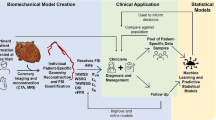Abstract
In this paper, we present a one-dimensional model for blood flow in arteries, without assuming an a priori shape for the velocity profile across an artery (Azer, Ph.D. thesis, Courant Institute, New York University, 2006). We combine the one-dimensional equations for conservation of mass and momentum with the Womersley model for the velocity profile in an iterative way. The pressure gradient of the one-dimensional model drives the Womersley equations, and the velocity profiles calculated then feed back into both the friction and nonlinear parts of the one-dimensional model. Besides enabling us to evaluate the friction correctly and also to use the velocity profile to correct the nonlinear terms, having the velocity profile available as output should be useful in a variety of applications. We present flow simulations using both structured trees and pure resistance models for the small arteries, and compare the resulting flow and pressure waves under various friction models. Moreover, we show how to couple the one-dimensional equations with the Taylor diffusion limit (Azer, Int J Heat Mass Transfer 2005;48:2735–40; Taylor, Proc R Soc Lond Ser A 1953;219:186–203) of the convection-diffusion equations to drive the concentration of a solute along an artery in time.




























Similar content being viewed by others
References
Azer K. Taylor diffusion in time-dependent flow. Int J Heat Mass Transfer 2005;48:2735–40
Azer K. A one-dimensional model of blood flow in arteries with friction, convection and unsteady Taylor diffusion based on the Womersley velocity profile. Ph.D. thesis, Courant Institute, New York University; 2006
Calfisch R, Majda G, Peskin CS, Strumolo G. Distortion of the arterial pulse. Math BioSci 1980; 229–60
Caro C, Pedley T, Schroter R, Seed W. The mechanics of the circulation. Oxford University Press; 1978
Chorin AJ, Marsden JE. A mathematical introduction to fluid mechanics, 3rd ed. New York: Springer; 1998
Coleman T, Harris J, Guyton A. Whole-body circulatory autoregulation and hypertension. Circ Res 1971;XXVIII and XXIX, 76–87
Courant R, Friedrichs K. Supersonic flow and shock waves. Springer, Applied Mathematical Sciences; 1999
Dong S, Karniadakis G, Karonis N. Cross-site computations on the teragrid. Comput Sci Eng 2005;7(5):14–23
Feinberg AW, Lax H. Studies of the arterial pulse wave. Circulation 1958;XVIII:1125–30
Formaggia L, Gerbau J-F, Nobile F, Quarteroni A. On the coupling of 3d and 1d Navier-Stokes equations for flow problems in compliant vessels. Comp Methods Appl Mech Eng 2001;191(6–7):561–82
Franklin S. Systolic blood pressure. Am J Hypertens 2004;17:49S–54S
Griffith T, Klassen P, Franklin S. Systolic hypertension: an overview. Am Heart J 2005;149(5):769–75
Guyton A, Hall J. Textbook of medical physiology. W. B. Saunders Company; 2000
Hoppensteadt FC, Peskin CS. Modeling and simulation in medicine and the life sciences. 2nd ed. Springer Verlag; 2002
Iberall A. Anatomy and steady flow characteristics of the arterial system with an introduction to its pulsatile characterisitcs. Math BioSci 1967;197:375–85
Lax H, Feinberg A, Cohen B. Studies of the arterial pulse wave; the normal pulse wave and its modification in the presence of human arteriosclerosis. J Chronic Dis 1956;3(6):618–31
Mendelsohn M. In hypertension, the kidney is not always the heart of the matter. J Clin Invest 2005;115(4):840–4
Nichols MW, O’Rourke MF. McDonald’s blood flow in arteries, theoretical, experimental and clinical principles. 4th ed. Edward Arnold; 1998
Nichols W. Clinical measurement of arterial stiffness obtained from noninvasive pressure waveforms. Am J Hypertens 2005;18:3S–10S
Olufsen MS, Peskin CS, Kim WK, Pedersen EM, Nadim A, Larsen J. Numerical simulation and experimental validation of blood flow in arteries with structured-tree outflow conditions. Ann Biomed Eng 2000;28:1281–99
Ottesen J, Olufsen M, Larsen J. Applied mathematical models in human physiology. SIAM Monographs on Mathematical Modeling and Computation; 2004
Pedley TJ. The fluid mechanics of large blood vessels. 3rd ed. Cambridge: Cambridge University Press; 1980
Richtmeyer, Morton. Difference methods for initial-value problems. 2nd ed. John Wiley and Sons; 1967
Saltzman J. An unsplit 3d upwind method for hyperbolic conservation laws. J Comput Phys 1994;115(1):153–68
Steele B, Taylor C. Simulation of blood flow in the abdominal aorta at rest and during exercise using a 1-d finite element method with impedance boundary conditions derived from a fractal tree. In: Summer Bioengineering Conference. Summer Bioengineering Conference; 2003
Stergiopulos N, Young DF, Rogge TR. Computer simulation of arterial flow with applications to arterial and aortic stenoses. J Biomech 1992;25:1477–88
Taylor G. Dispersion of soluble matter in solvent flowing slowly through a tube. Proc R Soc Lond Ser A 1953;219:186–203
Zamir M. On fractal properties of arterial trees. J Theor Biol 1999;197(4):517–26
Acknowledgments
The authors would like to thank Mette Olufsen for helpful discussion on structured trees, and for making available the MRI data of a healthy male subject which was recorded by E.M Pedersen and Y. Kim at Skejby University Hospital in Denmark. This research was supported by the Applied Computer Science Department at Merck & Co., Inc. We would especially like to thank Jeffrey Saltzman, Robert Nachbar and Christopher Tong for their interest in this work and for helpful discussions.
Author information
Authors and Affiliations
Corresponding author
Rights and permissions
About this article
Cite this article
Azer, K., Peskin, C.S. A One-dimensional Model of Blood Flow in Arteries with Friction and Convection Based on the Womersley Velocity Profile. Cardiovasc Eng 7, 51–73 (2007). https://doi.org/10.1007/s10558-007-9031-y
Published:
Issue Date:
DOI: https://doi.org/10.1007/s10558-007-9031-y




